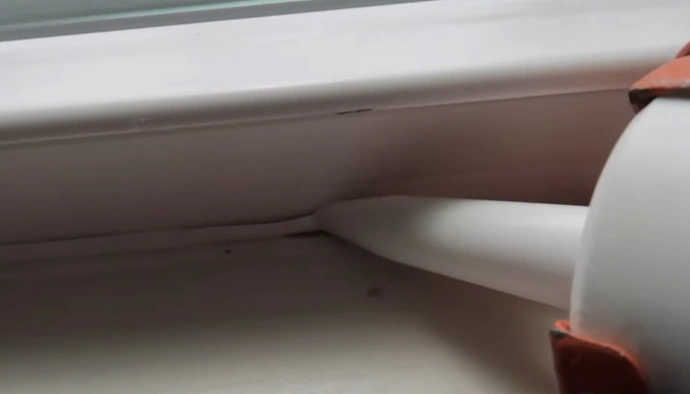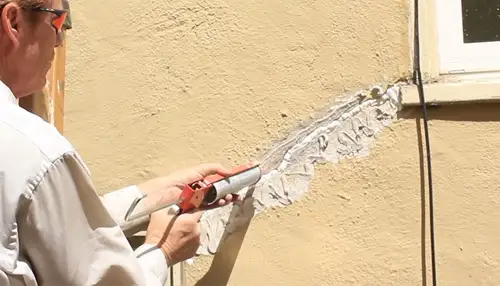Last Updated on June 29, 2022
One of the most common problems with caulk around windows is that it pulls away, allowing water to seep into the gaps and drywall. Over time, water can cause paint to peel and bubble, and loose caulk can make window glass rattle.
During bad weather, even slightly loose glass can break and injure occupants. Here are some things to look for when the caulk around windows cracks.
Problems with exterior caulk
Exterior caulk can create a good seal around your windows, preventing water damage and mildew. Cracks around your windows can also be a problem when trying to sell your home.
A touch-up of new caulk can help your home look cleaner. If you’re unsure whether exterior caulk around windows is a good idea, read on to learn more. Here are some common causes and how to fix them.
If you’ve ever noticed that your exterior caulk around windows is peeling off, you’re not alone. Water will seep into gaps around your windows, eventually leading to paint bubbles and peeling.
This problem is especially problematic during severe weather conditions, when high winds and rain can force water into even the smallest gaps.
And remember, caulk around windows can make your windows rattle. Even slightly loose panes can snap in a bad storm, damaging your furniture and injuring the people inside your home.
Another cause for exterior caulk cracking around windows is condensation. While leaking windows are a common problem, there are several things that you can do to prevent it.
First, make sure the caulk around the windows is weatherproof. You should also make sure the caulk is overlapping correctly.
Otherwise, water will flow over the seam and into the wood framing beneath. And don’t forget about the corner boards.
Next, determine what kind of exterior caulk you want to use. You can choose between acrylic caulk and polyurethane. Acrylic caulk has the advantage of being easy to use and smooth.
It also offers good adhesion and flexibility. This caulk is good for most exterior gaps that are no more than a quarter inch in width.
However, you’ll want to make sure to research the product before you buy it. It’s important to know that some of the cheaper acrylic brands will be of lesser quality than others.
You should also check the caulk around your windows. Sometimes the caulk will not cure properly and will crack. It may also have been improperly applied.
If you’re unsure, consult the manufacturer’s instructions before applying caulk to a window. Also, remember to let the caulk dry before painting. Depending on how good your caulk is, it should last at least five years.
Common caulk failures
Inadequate caulk around windows can lead to drafts and poor insulation, which increases energy costs. To minimize this problem, you should have your windows winterized.
Winterizing will help ensure optimal insulation during cold months and catch any issues before they cause more damage. Here are the most common caulk failures around windows. Listed below are some possible causes and solutions. If you notice a problem, contact a professional.
Poor adhesion is one of the biggest causes of caulk failure. If the sealant doesn’t stick to the surface, it can release in days, weeks, or months.
To avoid this, choose a quality caulk and follow its instructions exactly. The manufacturers will also provide you with specific cleaning guidelines.
If the problem persists, consider contacting a professional to help you with the process. You can also contact a professional painter for advice.
Regular caulk around windows looks better than a gap. When applied correctly, it emphasizes the lines of the house, making it look smarter. Moreover, it reduces energy costs.
Caulk around windows is a relatively easy task and requires little time. Before you start caulking, you should clean the surface thoroughly and ensure that the caulk is in its correct place. You should use a putty knife to remove old caulk from the window’s surface.
Besides sealing the edges of windows, proper caulking also helps prevent moisture intrusion, drafts, and heat leakage.
Performing it correctly can prevent these problems, and make the transition from warm to cool season a lot easier. Listed below are some common caulk failures that you should avoid.
There are also some common mistakes you can avoid making. Remember that caulk tends to harden and separate from the surface over time, so you may need to apply it again later.
Common caulk failures on interior caulk
There are some common mistakes that you should avoid when caulking around windows. Caulking should be applied around windows to seal them from the elements.
If the caulk does not adhere well, water may leak into the home. This can cause a number of problems. It is also important to remember that moisture around windows can encourage the growth of bacteria. If you want to avoid this, you should use foam rope instead of caulk.
Another common caulk failure is mold growth. If you notice mold on the caulk, then this material is no longer providing adequate protection.
If mold grows on the surface of the caulk, then moisture is leaking underneath and causing problems. This can cause allergies and physical damage to structures.
Though waterproof caulk will prevent mold growth, improper application of the material can still allow moisture to penetrate the structure. For these reasons, it is important to replace old caulk when renovating a building.
Inadequate sealing can also lead to drafts and poor insulation. This can increase your energy bills. If you notice any of these signs, it is best to hire a professional caulking company to replace the caulk or remove it completely.
You can also winterize your windows to ensure proper insulation during cold weather. This way, you can catch the problem early, preventing it from causing permanent damage to the structure.
If you have a problem with the old and cracked caulk, it is important to remove it. The old caulk will not adhere well and may leave moisture on the surface of the window.
To remove old caulk, you should clean the surface with a putty knife or other sharp tool. If the caulk is hard and is not removed easily, you can use a caulk remover gel to help you remove it.
Another common reason for the caulk to fail is that the trim is not properly nailed. Air and moisture changes can cause the caulk to crack and split, and you will have to wait for the caulk to dry properly before you can paint it.
This is referred to as the paint-ready period. If you follow these tips, your windows will remain safe and sound for years to come.
Common caulk failures on wooden windows
While vinyl or metal windows have easier to maintain exteriors, wooden windows can be susceptible to damage from water. Without the proper treatment, moisture can seep into wooden window frames and cause rotting.
In addition to compromising the aesthetics of the room, moisture can also affect the operability of the window frame, resulting in a sticky situation. Wooden windows can also be dangerous, especially if they’re made of solid wood.
Depending on the cause, window leaks can occur anywhere along the perimeter of the window. If the leak originates from a point inside the walls, the water will seep down and enter the window frame, where it will collect on the flat surfaces of the top and bottom.
If the caulk has become too old and cracked, a new application of window caulk could be necessary. This can solve the problem and restore the aesthetic appeal of your windows.
If you notice cracks around wooden windows, it may be due to cracked caulk. This can lead to water seeping into drywall or plaster, causing the paint to peel and bubble.
Severe storms can further aggravate the problem because they drive rain into even the smallest cracks or gaps. If this happens, the damage could be irreversible. For the best results, make sure to repair the caulk on your wooden windows as soon as possible.
Another common cause of a bumpy bead is caulking siding. While the edges of the window are smooth, textured siding will make the bead uneven.
If you’re unable to get a smooth bead, you can use a putty knife to scrape off the old caulk and create a new bead. If you can’t find a suitable putty knife, you can purchase one from Amazon or other retailers.
Another cause of leaking windows is the failure to caulk the window flange. In addition to the caulk failure, other factors may be to blame.
The installation isn’t good enough, and the caulk may not get into the framing in a timely manner. For example, if the caulk is not applied properly, the window might be too tight to fit properly.
Frequently Asked Questions (FAQs)
1. What is the main reason why caulk cracks around windows?
Caulk cracks around windows because it is not being applied correctly.
2. What are some of the other reasons why caulk cracks around windows?
In addition to the reasons mentioned in the previous answer, caulk can also crack around windows due to:
– Poor surface preparation before caulking
– Use of the wrong type of caulk for the job
– Poor application technique
– Use of an old or expired caulk
– Exposure to extreme temperatures or sunlight
3. How can you prevent caulk from cracking around windows?
To prevent caulk from cracking around windows, you can apply a layer of painter’s tape around the edge of the window before applying the caulk.
4. What are some of the best ways to repair caulk that has cracked around windows?
There are a few ways to repair cracked caulk around windows. One way is to use a utility knife to cut out the old caulk. Then, use a putty knife to apply new caulk to the area. Another way is to use a caulking gun to apply new caulk to the area.
Conclusion
Caulk around windows can crack for a variety of reasons, including expansion and contraction due to temperature changes, improper application, and aging. To avoid cracks, it is important to choose a high-quality caulk and to follow the manufacturer’s instructions for application.




